Today in History: December 21
O Radiant Dawn
What sorcery
within a night
has made a city street
into a fairy glade?
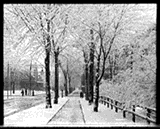
What…Fairy Glade?, circa 1900-1910.
Touring Turn-of-the-Century America, 1880-1920
Winter begins! The name "winter" comes from a Germanic term meaning "time of water" and refers to the seasonal precipitation. The winter solstice—the moment when the sun's apparent path is farthest south from the Equator—is used to officially mark winter's beginning. In the Northern Hemisphere, winter begins on the "shortest day" of the year, December 21 or 22, and lasts until March 20 or 22, the beginning of spring, marked by the vernal equinox, when day and night are equal in length. In the United States, this winter's solstice occurs on December 21 at 2:21 P.M. Eastern Standard Time, 7:21 P.M. Greenwich Mean Time. Those of us in the Southern Hemisphere, today celebrate the beginning of the summer season.

Skating on the Lake in Central Park, New York, New York
F.S. Armitage, [American Mutoscope & Biograph Co.], cameraman, February 5, 1900.
The Life of a City: New York, 1897-1906
In his extended meditation on the winter landscape, "A Winter Walk," Henry David Thoreau reflects:
Now commences the long winter evening around the farmer's hearth, when the thoughts of the indwellers travel far abroad, and men are by nature and necessity charitable and liberal to all creatures. Now is the happy resistance to cold, when the farmer reaps his reward, and thinks of his preparedness for winter…Henry David Thoreau, "A Winter Walk,"Excursions, p.134.
The Evolution of the Conservation Movement, 1850-1920
In October 1938, WPA interviewer May Swenson recorded a few "tall tales swapped by the lumberjacks during long winter months." John River's story, "It Was So Cold That," about toughing out a Wisconsin cold spell so extreme "that any thermometer couldn't hold together for a minute" is particularly delightful.
Without food in camp, the lumberjacks sent Happy Jack, famous for the derby that never left his head, to drill a hole in the icy river and fish:
We rigged him up in all the coats and jackets and woolen shirts we could spare and still keep ourselves from freezin…and four pairs woolen socks and his leather boots and top o' them a pair hightopped rubber boots—and when Happy Jack was ready to go out…he was as big as a brood mare and musta weighed pretty near as much.
Wal, Happy Jack picked up the torch and the saw in his mits—he had 6 pair mits on, 3 wool and 3 leather, furlined—and muffled up to the ears. And on top of his ears o'course was settin that little old derby…
Now we waited and waited for Jack to come back…John Rivers, "Tall Tales in the Lumberjack Region," September 29, 1938.
American Life Histories, 1936-1940
Find out if Happy Jack returned with a catch. Go to "Tall Tales in the Lumberjack Region" and scroll down to continue the story.
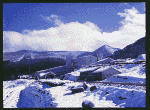
First Snow of the Season, Foothills of Little Belt Mountain, Montana
Russell Lee, photographer, August 1942.
FSA/OWI Color Photographs, 1938-1944
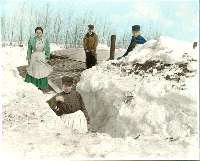
Digging Out After a Three-Day Snowstorm
John McCarthy, photographer, circa 1913.
The Northern Great Plains, 1880-1920
- For yet more stories of winters past, search in the American Life Histories, 1936-1940 collection.
- Search on the terms winter and snow in American Environmental Photographs, 1891-1936 for beautiful images from the Western and Midwestern United States. See, for example, Holly after a Snowstorm taken in the St. Louis, Missouri Botanical Garden.
- Search Washington As It Was, 1923-1959 and Touring Turn-of-the-Century America, 1880-1920 for hundreds of photographs of winter scenes.
- Search the Buckaroos in Paradise collection on the term winter to learn about winter chores on the ranch. The film Butchering Hogs (circa 1945) is one example of such chores; Feeding Cattle in Winter is another.
- Many pioneer reminiscences of the season are available in Pioneering the Upper Midwest, 1820-1910. For example, a full text search on the word blizzard will retrieve "Six Months of Winter" a chapter from Between the Iron and the Pine: a Biography of a Pioneer Family and a Pioneer Town by Lewis Reimann.
"Footprints in the Snow,"
Bogue Ford, unaccompanied vocals, recorded September 3, 1939.
California Gold: Folk Music from the Thirties, 1938-1940
![]()
Listen to this recording
(Real Audio format)
![]()
Listen to this recording
(wav format, 452KB)
King of the Jukeboxes
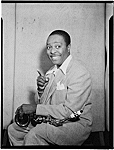
Portrait of Louis Jordan, Paramount Theater,(?) New York, New York, circa July 1946.
William P. Gottlieb Photographs from the Golden Age of Jazz
On December 21, 1946, Louis Jordan's single, "Let the Good Times Roll," debuted on the Rhythm and Blues charts. Over the next twenty-two weeks, the recording held fast to the chart, occupying the number two position for four weeks. "Let the Good Times Roll" was paired with the fast paced and humorous "Ain't Nobody Here But Us Chickens"—a phenomenally popular release that ranked number one for seventeen weeks. Such success was commonplace for Jordan. From 1943 until 1950, his singles topped the R&B chart more than 25% of the time. Fifteen hits crossed over to the pop charts.
Born in Brinkley, Arkansas in 1908, Louis Jordan started playing saxophone at seven. As a teenager, he toured with the famed Rabbit Foot Minstrels and backed blues singers including Bessie Smith. In the 1930s, Jordan settled in New York City. There, he began performing under band leader Chick Webb. Webb pulled the saxophonist out of the ensemble to sing the novelty songs that would remain a crucial part of Jordan's repertoire.
By 1938, Jordan headed his own band, showcasing his talents as vocalist, conductor, and comedian. Soon, Louis Jordan and His Tympany Five were making popular recordings of songs like "Whats the Use of Getting Sober (When your Gonna Get Drunk Again)," "The Chicks I Pick Are Slender, Tender, and Tall," and Johnny Mercer's "G.I. Jive."
Jordan's swinging style, once described as "jazz with a broad grin," combined musical innovation with humor and jive talk. He introduced jump blues and boogie-woogie to the masses, paving the way for rock and roll. In the course of his career, this excellent saxophonist and talented entertainer appeared in films and recorded with prominent artists including Louis Armstrong, Bing Crosby, and Ella Fitzgerald.
Louis Jordan at the Peak of His Career
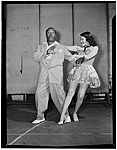
With Dancer, Paramount Theater,(?) New York, New York, circa July 1946.
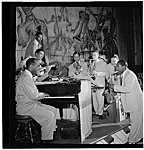
Louis Jordan With the Tympany Five, New York, New York, between 1946 and 1948.

Portrait of Louis Jordan, Paramount Theater,(?) New York, New York, circa July 1946
From William P. Gottlieb - Photographs from the Golden Age of Jazz
Jordan's career foundered in the 1950s and repeated attempts to stage a comeback failed. Unfortunately for the band leader, his sound was rapidly eclipsed by the very music he helped create. The year Jordan abandoned the label, Decca produced Bill Haley's "Shake, Rattle and Roll" in a style closely modeled on Jordan's. Like many songs Louis Jordan introduced, "Let the Good Times Roll" became an R&B standard. Recorded by Ray Charles, the song encored on the charts in 1960.
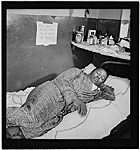
Portrait of Louis Jordan, Paramount Theater,(?) New York, New York
William P. Gottlieb, photographer, ca. July 1946.
Photographs from the Golden Age of Jazz
- Louis Jordan died in 1975 and was inducted into the Rock and Roll Hall of Fame twelve years later. Visit the Rock and Roll Hall of Fame's Louis Jordan feature to hear a bit of "Choo Choo Ch'Boogie."
- Examine the collection Photographs from the Golden Age of Jazz. Search on the name of a favorite jazz artist, or browse by name, subject, or venue. Don't miss the special presentation In His Own Words: Photos and Commentary by William Gottlieb.
- Explore the roots of R&B. Search Southern Mosaic: The John and Ruby Lomax 1939 Southern States Recording Trip on blues to hear over eighty recordings of traditional blues songs. Don't miss "Po' Boy," "Shine On," and "I Got a Home in New Orleans."
- See Today in History features on musical legends Jelly Roll Morton, W.C. Handy, George Gershwin, Frank Sinatra, Ella Fitzgerald and Billie Holiday.
The Hoover Dam Story
On December 21, 1928, President Calvin Coolidge signed the Boulder Canyon Project Act intended to dam the fourteen hundred mile Colorado River and distribute its water for use in Arizona, California, Colorado, Nevada, New Mexico, Utah, and Wyoming. Hoover Dam, considered a wonder of civil engineering, was constructed in Black Canyon, on the Arizona-Nevada border. Often referred to as Boulder Dam, the site was officially named after Herbert Hoover, an engineer actively engaged in the dam's development and distribution of its water rights, and president-elect on this day in 1928.
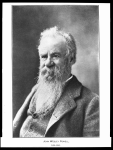
John Wesley Powell, between 1890-1910.
Evolution of the Conservation Movement, 1850-1920
In 1869, Civil War-veteran Major. John Wesley Powell was the first person on record to travel the length of the Colorado River. As head of the U.S. Geographical and Geological Survey of the Rocky Mountain Region, Powell was also one of the first to describe the Southwest's geography in his work Report on the Lands of the Arid Region of the United States.
In 1900, William E. Smythe envisioned an irrigated desert in The Conquest of Arid America. This publication generated much popular support for the Newlands Reclamation Act signed in 1902 by President Theodore Roosevelt whose Progressive-era conservation policy linked democratic opportunity to control of natural resources.
Less scientific but still influential in the decision to dam the Colorado River, a powerful and unpredictable force of nature in the arid Southwest, were the experiences of the area's denizens:
I went to California in 1906, and worked for the CLM Cattle Company. The cattle men in that country dreaded the overflows from the Colorado River, caused by the melting of snow in the mountains and spring rains. Sometimes when the cattle were caught in those overflows we'd have to go out in boats and pull 'em out. It was certainly mean work. It was very brushy too. We always carried our branding ring with us, and if we ran across an unbranded calf we'd brand him on the spot."M. C. Manuel," Annie McAulay, interviewer, Maverick, Texas, January 19, 1938.
American Life Histories, 1936-1940
When flooding from the Colorado wiped out nascent farming and irrigation efforts in major portions of the Imperial and Yuma Valleys between 1905 and 1916, the die was cast favoring technological control of the river.
"Personal Greetings," Harry Hansen, at Camp 21, Yosemite Sugar Pine Lumber Co., Incline, Calif., to Pat and Bogue Ford at Central Valley.
They all worked together on the Deadwood Dam, Idaho and Boulder Dam, Nevada.
August 2, 1939.
California Gold: Folk Music from the Thirties, 1938-1940
![]()
Real Audio format
![]()
wav format
Construction centered first on diversion of the Colorado through four fifty-six-foot diameter tunnels driven through the canyon walls—one of the toughest aspects of the project. But with the Great Depression at its depth, 12,000 applicants inquired about jobs within the project's first two weeks. Poor labor conditions included two days of unpaid leave a year and constant exposure to carbon monoxide fumes and noise. A one-week strike in 1931 netted no immediate improvements, but the following year the contractor, Six Companies, did improve worker housing. When Harold Ickes became Secretary of the Interior he insisted they also take steps toward desegregation.
After two years of back-breaking preparation work, the dam's first concrete was poured in June 1933. Two years later the dam started impounding water into Lake Mead, and the last concrete was poured. When President Franklin D. Roosevelt dedicated the dramatic site in September 1935 he said:
I have the right once more to congratulate you who have builded [sic] Boulder Dam [Hoover Dam], and on behalf of the nation, to say to you: 'Well done.'
- Browse the Subject Index of Prosperity and Thrift, 1921-1929 to learn more of the widespread prosperity of the Coolidge years and the nation's transition to a mass consumer economy.
- Search the pictorial collections of American Memory on the terms construction and dam for related images. See, for example, photographs by FSA/OWI photographer Russell Lee showing the construction of Shasta Dam.
- At 5:30 P.M. on December 7, 1941, Hoover dam was closed to the public and traffic moved over the dam only under convoy for the duration of World War II. Search the Today in History Archive on the term World War II to learn more about the war and about civilian mobilization during it.
- Evolution of the Conservation Movement, 1850-1920 documents the formation and cultural foundations of the effort to conserve and protect America's natural heritage. Search, for example, on terms like John Wesley Powell, William Smythe, Theodore Roosevelt, and reclamation to learn more. Also see the related special presentation Chronology of Selected Events in the Development of the American Conservation Movement, c.1850-1920.
![Salix [and] Populus along a dry Colorado River floodplain, Yuma, Arizona](images/1221soil.gif)
Salix and Populus along a Dry Colorado River Floodplain, Yuma, Arizona, between 1891-1936.
American Environmental Photographs, 1891-1936 - Search on the term reclamation in Theodore Roosevelt: His Life and Times to see film of Roosevelt Dam, another major irrigation project which developed out of Roosevelt's commitment to reclamation of desert land.
- Learn more from the online presentation Hoover Dam, produced by WGBH-TV in conjunction with the Public Broadcasting Service (PBS) series "The American Experience."